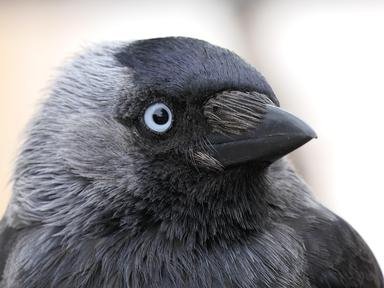Quiz Answer Key and Fun Facts
1. A resident breeding species in Britain, 'Garrulus glandarius' is a member of the crow family. Most often found in mixed woodlands containing oaks, it is a habitual hoarder of acorns. You can expect to be woken up by the rasping screech of which bird?
2. This small songbird from the kinglet family is essentially one species within the group of Old World warblers. 'Regulus regulus' is known as the "king of the birds" in European folklore. Its call is a thin, high-pitched 'zee' repeated at regular intervals. Which bird is this?
3. Resident year-round in Great Britain and across much of Europe, its distinctive black head makes 'Parus major' a distinctive bird to spot. A particularly vocal bird with more than 40 calls, most people will recognize the one that sounds like a squeaky wheelbarrow wheel. Which bird is this?
4. A slender streamlined body, long pointed wings and a short bill mean that 'Riparia riparia' is adapted to aerial feeding. Sometimes called a bank swallow, this bird is common throughout the northern hemisphere in the summer before it migrates south for the winter. Which bird is this?
5. A summer-time breeding visitor to Great Britain and much of Europe as far east as the Urals, 'Phylloscopus sibilatrix' winters in tropical Africa. Look for it in shady mature woodlands, particularly around beech and sessile oak trees. Its yellow supercilium, throat and upper breast make it easy to spot. Which bird is this?
6. A resident breeder in Great Britain, 'Sylvia atricapilla' is most often seen in mature deciduous woodland. You might identify him by the rich musical song which often ends with a loud high-pitched crescendo. Which bird is this?
7. A short-tailed bird with a long bill, 'Sitta europaea' is a resident breeder in Britain and throughout most temperate regions of Europe and Asia. A vocal bird with a repeated loud "dwip" call, it can most often be seen in mature woodlands with large, old trees, particularly oak. Which bird is this?
8. Resident breeders in Britain and across much of temperate Europe and Asia, 'Sturnus vulgaris' is common in urban areas, where man-made structures provide ideal nesting and breeding sites. A particularly noisy bird with a gift for mimicry, has a varied but surprisingly unmusical song. Which bird is this?
9. Sometimes called a stormcock, 'Turdus viscivorus' is noted for its loud and far-carrying song. Common year round in Britain and throughout Europe, Asia and north Africa, you will most often see him in open woods, parks, hedges and cultivated land. Which bird is this?
10. A resident breeder throughout Great Britain, 'Anthus pratensis' generally moves to the coastal lowlands for the winter months. Commonly found in pasture, bogs, and on moorland, it feeds on the ground but uses shrubs, fences or electricity wires as vantage points to spot predators. Which bird is this?
Source: Author
EnglishJedi
This quiz was reviewed by FunTrivia editor
guitargoddess before going online.
Any errors found in FunTrivia content are routinely corrected through our feedback system.

